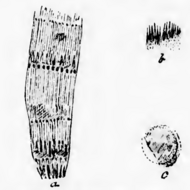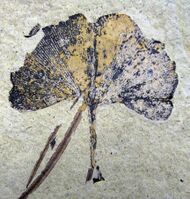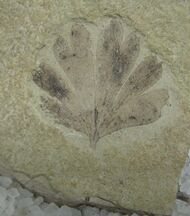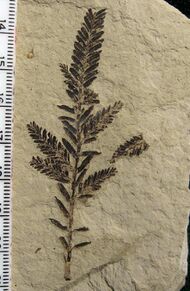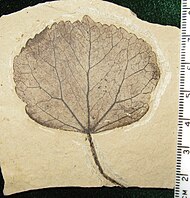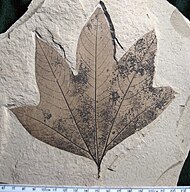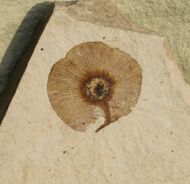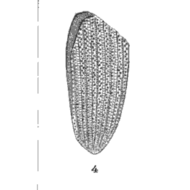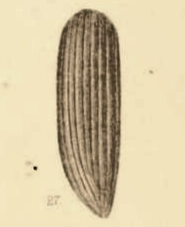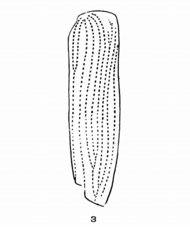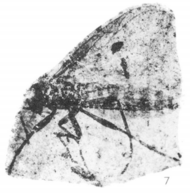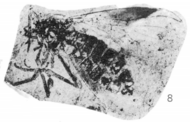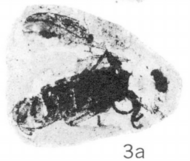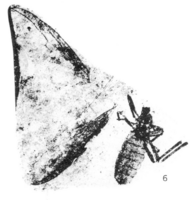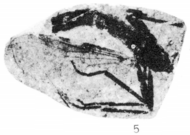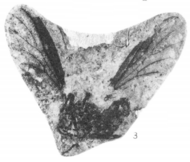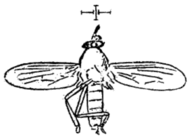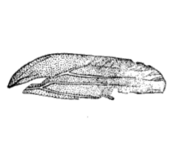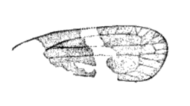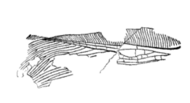Earth:Allenby Formation
| Allenby Formation Stratigraphic range: Ypresian 52.5–48 Ma | |
|---|---|
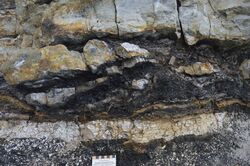 Alternating Princeton Chert and coal sequences | |
| Type | Geological formation |
| Unit of | Princeton Group, Eocene Okanagan Highlands |
| Sub-units | Princeton Chert, Vermillion Bluffs Shale |
| Overlies | Cedar Formation |
| Area | 300 km2 (120 sq mi)[1] |
| Thickness | 1,860–2,100 m (6,100–6,890 ft)[1] |
| Lithology | |
| Primary | Shale, sandstone |
| Other | Coal–breccia, coal–chert |
| Location | |
| Coordinates | [ ⚑ ] : 49°22.6′N 120°32.8′W / 49.3767°N 120.5467°W |
| Paleocoordinates | [ ⚑ ] 53°06′N 107°30′W / 53.1°N 107.5°W |
| Region | British Columbia |
| Country | |
| Extent | Princeton Basin & Tulameen basin |
| Type section | |
| Named for | Allenby, British Columbia |
| Named by | Shaw |
| Year defined | 1952 |
| Lua error in Module:Location_map/multi at line 27: Unable to find the specified location map definition: "Module:Location map/data/British Columbia" does not exist. | |
The Allenby formation is a sedimentary rock formation in British Columbia which was deposited during the Ypresian stage of the Early Eocene. It consists of conglomerates, sandstones with interbedded shales and coal. The shales contain an abundance of insect, fish and plant fossils known from 1877 and onward, while the Princeton Chert was first indented in the 1950's and is known from anatomically preserved plants.
There are several notable fossil producing localities in the Princeton & Tulameen basins. Historical collection sites included Nine Mile Creek, Vermilian Bluffs, and Whipsaw Creek, while modern sites include One Mile Creek, Pleasant Valley, Thomas Ranch, and the Princeton Chert.
Extent and correlation
The Allenby is estimated to have an overall extent of approximately 300 km2 (120 sq mi), though actual outcroppings of the formation make up less than 1% of the formation, while other exploratory contact is via boreholes and mines. The half-graben which contains the formation is separated into two major depositional basins, the Princeton basin around Princeton, British Columbia and the Tulameen basin centered approximately 17 km (11 mi) west. The grabens extensional faults at the eastern side of the basin place the hanging wall Allenby strata in contact with much older foot wall strata of the Nicola Formation which dates to the Upper Triassic.[1][2][3]
The Allenby Formation is the southern-most of the Eocene Okanagan Highlands lakes in British Columbia, and second most southern site after the Klondike Mountain Formation of Republic, Washington and northern Ferry County. In British Columbia, the formation is coeval to the Tranquille Formation, known from the McAbee Fossil Beds and Falkland site, the Coldwater Beds, known from the Quilchena site, and Driftwood Canyon Provincial Park. The highlands, including the Allenby Formation, have been described as one of the "Great Canadian Lagerstätten"[4] based on the diversity, quality and unique nature of the biotas that are preserved. The highlands temperate biome preserved across a large transect of lakes recorded many of the earliest appearances of modern genera, while also documenting the last stands of ancient lines.[4]
The warm temperate uplands floras of the Allenby Formation and the highlands, associated with downfaulted lacustrine basins and active volcanism are noted to have no exact modern equivalents, due to the more seasonally equitable conditions of the Early Eocene. However, the formation has been compared to the upland ecological islands in the Virunga Mountains within the Albertine Rift of the African rift valley.[5]
The earliest work in the region was on exploratory expeditions in 1877 and 1878, with fossils collected in the areas of Nine-Mile Creek, Vermilian Bluffs on the Similkameen River, and Whipsaw Creek. While reporting on additional plant fossils collected from British Columbia, Penhallow (1906) noted the likely coeval status of the Princeton basins with many of the sites now considered the Okanagan Highlands.[6] Modern collecting has centered on the areas around One Mile Creek, Pleasant Valley, and Thomas Ranch.[2]
Age
The age estimates for the Allenby Formation have varied a number of times since the first explorations happened in the 1870s. Shaw (1952) dated the formation as Oligocene, an age followed by Arnold (1955).[7][8] Half a decade later, the older age of 48 ± 2 million years old was first suggested, with a younger age being suggested at 46.2 ± 1.9 million years old in 2000 and an older date of 52.08 ± 0.12 million years ago obtained from uranium–lead dating of zircons from Vermilion Bluffs shale in 2005.[1]
Lithology
The Allenby is composed of cyclical sedimentation events that were deposited along the course of a river-system in conjunction with depositional areas from nearby lakes and wetlands. Coeval volcanic eruptive events are recorded as interbeds of tephras and lavas, while the riverine course is marked with depositional areas of conglomerates and sandstones. The quieter environments are noted for finer layers of shales and coalified layers.[1]
The coal seams throughout the formation are typically sub-bituminous.[1]
Notable in conjunction with the coal seams are sections of chert which formed during silica rich periods. The rapid cyclical changes from coal to chert and back are not noted in any other fossil locality in the world. An estimated 49 coal-chert cycles are known, though the exact conditions for this process are not well understood. Silica rich volcanic episodes in the region during deposition would have been needed for formation of the cherts, while slowly moving waters and gently subsiding terrains would be needed for the peats and fens to accumulate. Rates of organic deposition in swamps have been estimated at 0.5–1 mm (0.020–0.039 in) in modern temperate climates, this suggests the time needed for each 10–20 cm (3.9–7.9 in) chert layer would be at least 100 years or more, with the full sequence of cycles taking place over no more than 15,000 years.[1]
Palynoflora
Palynological analysis of samples from the Thomas ranch site by Dillhoff et al. (2013) resulted in the identification of 32 pollen and spore types that were assignable to family or genus level, with a total number of distinct pollen and spore types, including unassignable morphotypes, number over 70. The predominant pollens of the site are conifers, which make up between 85%–97% of the total pollens, while the angiosperm pollens are dominated by members of Betulaceae.[2]
Several pteridophyte families and genera are represented as spore fossils alone, without corresponding megafossil records, including Lycopodiaceae, Osmundaceae, and Schizaeaceae. Similarly, at least three additional conifer genera are only present as pollen fossils and up to 12 angiosperms are present in the pollen record. Sometimes considered a Biostratgraphic index fossil, the angiosperm palynospecies Pistillipollenites macgregorii has been recovered from several sites in the Allenby Formation, while the palynospecies Erdtmanipollis pachysandroides is rare, having only been reported from the formation twice.[2]
| Family | Genus | Species | Pollen/Macrofossil | Notes | Images |
|---|---|---|---|---|---|
|
Unidentified[2] |
Pollen |
A holly palynomorph |
|||
|
Cf. †Sabal granopollenites[2] |
Pollen |
A palm palynomorph |
|||
|
†Erdtmanipollis |
†Erdtmanipollis pachysandroides[2] |
Pollen |
A box family palynomorph |
||
|
Unidentified[2] |
Pollen & macrofossils |
An alder palynomorph |
|||
|
Unidentified[2] |
Pollen & macrofossils |
A birch palynomorph |
|||
|
Unidentified[2] |
Pollen |
A hornbeam palynomorph |
|||
|
unidentified[2] |
Pollen |
A hazelnut palynomorph |
|||
|
unidentified[2] |
Pollen |
A Cunninghamia like palynomorph |
|||
|
Sequoiapollenites |
Unidentified[2] |
Pollen & macrofossils |
A redwood palynomorph |
||
|
Taxodiaceaepollenites |
Unidentified[2] |
Pollen & macrofossils |
A Taxodioideae subfamily palynomorph |
||
|
Cf. Elaeagnus |
Unidentified[2] |
Pollen |
An elaeagnaceous palynomorph, similar to oleaster |
||
|
unidentified |
Unidentified[2] |
Pollen |
An ericaceous palynomorph of uncertain affinity |
||
|
Unidentified[2] |
Pollen |
A chestnut palynomorph |
|||
|
Unidentified[9] |
Pollen |
A fagaceous palynomorph |
|||
|
"Fagus Pollen type 3"[9] |
Pollen |
A beech palynomorph |
|||
|
"Fagus Pollen type 2"[9] |
Pollen |
A beech palynomorph |
|||
|
†Paraquercus |
†Paraquercus eocaena[9] |
Pollen |
A fagaceous palynomorph |
||
|
"Quercus Pollen type 1"[9] |
Pollen |
An oak palynomorph, similar to Quercus Group Lobatae pollen |
|||
|
"Quercus Pollen type 2"[9] |
Pollen |
An oak palynomorph, ancestral type with Quercus Group Ilex morphology |
|||
|
†Trigonobalanopsis |
Unidentified[9] |
Pollen |
A fagaceous palynomorph |
||
|
Unidentified |
Unidentified[9] |
Pollen |
A Fagoideceous palynomorph |
||
|
Cf. Quercus |
Unidentified[2] |
Pollen |
|||
|
†Cycadopites |
†Cycadopites follicularis[2] |
Pollen & macrofossils |
A Gingko palynomorph |
||
|
Unidentified[2] |
Pollen |
A sweet gum palynomorph |
|||
|
Unidentified[2] |
Pollen |
A hickory palynomorph |
|||
|
Unidentified[2] |
Pollen |
A hickory palynomorph |
|||
|
Unidentified[2] |
Pollen |
A lycopod palynomorph |
|||
|
Unidentified[2] |
Pollen |
A linden palynomorph |
|||
|
Osmundasporites |
Unidentified[2] |
Pollen |
An osmundaceous fern palynomorph |
||
|
Unidentified[2] |
Pollen & macrofossils |
A fir palynomorph |
|||
|
†Alisporites |
Unidentified[2] |
Pollen |
A pine family palynomorph |
||
|
Unidentified[2] |
Pollen |
A Picea palynomorph |
|||
|
Unidentified[2] |
Pollen & macrofossils |
A Pinus palynomorph |
|||
|
†Pityosporites |
Unidentified[2] |
Pollen |
A pine family palynomorph |
||
|
Unidentified[2] |
Pollen & macrofossils |
A Pseudolarix palynomorph |
|||
|
Unidentified[2] |
Pollen |
A Tsuga palynomorph |
|||
|
Cf. Larix |
Unidentified[2] |
Pollen |
A Laricoidae palynomorph, similar to larch |
||
|
Cf. Pseudotsuga |
Unidentified[2] |
Pollen |
A Laricoidae palynomorph, similar to pseudotsuga |
||
|
Unidentified[2] |
Pollen |
A Platanus palynomorph |
|||
|
Unidentified[2] |
Pollen |
A Potamogeton palynomorph |
|||
|
Unidentified |
Unidentified[2] |
Pollen & macrofossils |
Rose famnily palynomorphs |
||
|
Unidentified[2] |
Pollen |
A willow palynomorph |
|||
|
Unidentified[2] |
Pollen & macrofossils |
A duck weed palynomorph |
|||
|
Acer |
Unidentified[2] |
Pollen & macrofossils |
A maple palynomorph |
||
|
Unidentified[2] |
Pollen & macrofossils |
A horse chestnut palynomorph |
|||
|
Unidentified |
Unidentified[2] |
Pollen |
A sapotaceous palynomorph |
||
|
Unidentified[2] |
Pollen |
A yew palynomorph |
|||
|
Unidentified[2] |
Pollen & macrofossils |
An elm palynomorph |
|||
|
†Pistillipollenites |
†Pistillipollenites macgregorii[2] |
Pollen |
A palynomorph of uncertain affinity, possibly a Gentianaceae or Euphorbiaceae species |
Compression paleobiota
A group of six mosses were described from the Allenby Formation by Kuc (1972, 1974) representing the genera Ditrichites, Hypnites and Plagiopodopsis, with two species placed in the morphogenus Muscites.[10][11] Dillhoff et al. (2013) identified twelve distinct gymnosperm taxa spanning the families Cupressaceae, Ginkgoaceae, and Pinaceae. While being the minority component of the Thomas Ranch flora by total fossil numbers, angiosperms have a higher diversity, with 45 distinct morphotypes represented as foliage, reproductive structures, or both. Seventeen of the morphotypes are identifiable to genus or species, with members of the family Betulaceae being most prominent. At least common one leaf type is suggested to possibly represent an extinct plant order, but has not been described.[2] Only two pteridophyte species have been described from the compression flora, Azolla primaeva by Penhallow (1890) and Equisetum similkamense by Dawson (1878).[12][8]
The following fossil conifers, pteridophytes, ginkgophytes and bryophytes have been described from the Allenby Formation:
Bryophytes
| Family | Genus | Species | Authority | Notes | Images |
|---|---|---|---|---|---|
|
Hypnites |
(Kuc) Miller |
An amblystegiaceous moss |
|||
|
Hypnites |
(Kuc) Miller |
An amblystegiaceous moss |
|||
|
†Plagiopodopsis |
(Kuc) Miller |
A bartramiaceous moss |
|||
|
†Ditrichites |
†Ditrichites fylesi[11] |
Kuc |
|||
|
incertae sedis |
†Muscites |
†Muscites maycocki[11] |
Kuc |
A moss of uncertain placement |
|
|
incertae sedis |
†Muscites |
†Muscites ritchiei[11] |
Kuc |
A moss of uncertain placement |
Pteridophytes
| Family | Genus | Species | Authority | Notes | Images |
|---|---|---|---|---|---|
|
Dawson |
|||||
|
(Penhallow) Arnold |
A mosquito fern |
Gingkophytes
| Family | Genus | Species | Authority | Notes | Images |
|---|---|---|---|---|---|
|
A ginkgo |
|||||
|
Mustoe, 2002 |
A ginkgo with highly dissected leaves |
Pinophytes
| Family | Genus | Species | Authority | Notes | Images |
|---|---|---|---|---|---|
|
†Chamaecyparis linguaefolia[15] |
(Lesquereux) MacGinitie |
||||
|
(Newberry) Chaney |
A dawn redwood First identified as "Sequoia" brevifolia, "S." heeri. "S." langsdorfii (in part), "S." nordenskiöldi, & Taxodium distichum miocenum (in part) |
||||
|
Lesquereux |
A redwood |
||||
|
(Sternberg) Heer |
First identified as "Sequoia" angustifolia, |
||||
|
Shorn & Wehr, 1986 |
Oldest true fir described |
||||
|
Undescribed[15] |
Miller |
A spruce |
|||
|
†Pinus monticolensis[15] |
A pinaceous winged seed |
||||
|
†Pinus trunculus[15] |
Dawson, 1890 |
||||
|
†Pinus tulameenensis[15] |
Penhallow |
||||
|
(J.Nelson) Rehder |
Originally identified as Pseudolarix americana,[15] then as Pseudolarix arnoldii[18] |
||||
|
Gooch |
Angiosperms
| Family | Genus | Species | Authority | Notes | Images |
|---|---|---|---|---|---|
|
Wolfe & Wehr |
A sumac |
||||
|
†Paleoallium |
†Paleoallium billgenseli[20] |
Pigg, Bryan, & DeVore |
An onion relative |
||
|
Bogner, Johnson, Kvaček & Upchurch |
|||||
|
(Berry) Wolfe & Wehr |
An Alder |
||||
|
Wolfe & Wehr |
A birch |
||||
|
†Palaeocarpinus |
†Palaeocarpinus stonebergae[22] |
Pigg, Manchester, & Wehr |
A coryloid genus |
||
|
†Cercidiphyllum obtritum[19] |
(Dawson) Wolfe & Wehr |
A katsura |
|||
|
†Fagopsis |
†Fagopsis undulata[19] |
(Knowlton) Wolfe & Wehr |
A beech |
||
|
Undescribed[2] |
A beech species Not described to species | ||||
|
Undescribed[2] |
A gooseberry species |
||||
|
Radtke, Pigg & Wehr |
A winter-hazel species |
||||
|
Undescribed[23] |
A wingnut |
||||
|
Undescribed[23] |
A laural species |
||||
|
Berry |
A laural species |
||||
|
Undescribed[24] |
An extinct sterculioid flower |
||||
|
Dawson |
|||||
|
Wolfe & Wehr |
A dove-tree relative |
||||
|
Macginicarpa |
Undescribed[2] |
Manchester |
A sycamore morphospecies |
||
|
†Macginitiea gracilis[19] |
(Lesquereux) Wolfe & Wehr |
A sycamore |
|||
|
Unidentified[25] |
A service berry |
||||
|
DeVore, Moore, Pigg, & Wehr |
A snow wreath |
||||
|
†Stonebergia columbiana[27] |
Wolfe & Wehr |
A Sorbarieae genus |
|||
|
Acer |
†Acer princetonense[28] |
Wolfe & Tanai |
A maple |
||
|
Acer |
Wolfe & Tanai |
A maple |
|||
|
Acer |
†Acer stockeyae[28] |
Wolfe & Tanai |
A maple |
||
|
Acer |
Wolfe & Tanai |
A maple |
|||
|
Acer |
Wolfe & Tanai |
A maple |
|||
|
Acer |
Wolfe & Tanai |
A maple |
|||
|
Acer |
†Acer wehri[28] |
Wolfe & Tanai |
A maple |
||
|
McClain and Manchester |
A Dipteronia species |
||||
|
Pigg et al. |
A Tetracentron relative |
||||
|
Zizyphoides |
Undescribed[2] |
A trochodendraceous species |
|||
|
Denk & Dillhoff |
An elm |
||||
|
Cf. Urticeae |
Undescribed[5] |
||||
|
†Chaneya |
†Chaneya tenuis[31] |
(Lesquereux) Wang & Manchester |
A sapindalean flower of uncertain affiliations |
Mollusks
| Family | Genus | Species | Authority | Notes | Images |
|---|---|---|---|---|---|
|
†Micropyrgus |
†Micropyrgus camselli[32] |
L.S. Russell, 1957 |
A hydrobiid mud snail |
||
|
†Stagnicola tulameenensis[32] |
L.S. Russell, 1957 |
A lymnaeine pond snail |
|||
|
†Aplexa ricei[32] |
L.S. Russell, 1957 |
An aplexine bladder snail |
|||
|
†Physa saxarubrensis[32] |
L.S. Russell, 1957 |
A physine bladder snail |
|||
|
†Ferrissia arionoides[32] |
L.S. Russell, 1957 |
An ancylinine ramshorn snail |
|||
|
Gyraulus? |
Indeterminate[32] |
L.S. Russell, 1957 |
A possible planorbinine ramshorn snail |
||
|
Indeterminate[32] |
L.S. Russell, 1957 |
A possible sphaeriine fingernail clam |
Insects
Coleopterans
| Family | Genus | Species | Authority | Notes | Images |
|---|---|---|---|---|---|
|
Unidentified |
Unidentified[33] |
A soldier beetle |
|||
|
Unidentified |
Unidentified[33] |
A caraboid superfamily beetle |
|||
|
†Cryptocephalites |
†Cryptocephalites punctatus[34] |
Scudder, 1895 |
|||
|
†Galerucella picea[35] |
Scudder, 1879 |
||||
|
Cryptohypnus? |
†Cryptohypnus? terrestris[35] |
Scudder, 1879 |
|||
|
Elaterites |
Undescribed[34] |
Scudder, 1895 |
A click beetle |
||
|
†Limonius impunctus[34] |
Scudder, 1895 |
||||
|
†Tenebrio primigenius[35] |
Scudder, 1879 |
||||
|
†Trox oustaleti[35] |
Scudder, 1879 |
Dipterans
| Family | Genus | Species | Authority | Notes | Images |
|---|---|---|---|---|---|
|
†Penthetria? fryi[36] |
Rice, 1959 |
A marchfly |
|||
|
†Penthetria whipsawensis[36] |
Rice, 1959 |
A marchfly |
|||
|
(Handlirsch, 1910) |
A marchfly |
||||
|
(Handlirsh, 1910) |
A marchfly |
||||
|
†Plecia curtula[36] |
(Handlirsch, 1910) |
A marchfly |
|||
|
†Plecia dilatata[36] |
(Handlirsch, 1910) |
A marchfly |
|||
|
†Plecia elatior[36] |
(Handlirsch, 1910) |
A marchfly |
|||
|
†Plecia minutula[36] |
Rice, 1959 |
A marchfly |
|||
|
†Plecia nana[36] |
(Handlirsh, 1910) |
A marchfly |
|||
|
†Plecia pictipennis[36] |
(Handlirsh, 1910) |
A marchfly Penthetria lambei (1910), Penthetria ovalis (1910), & Penthetria separanda (1910) considered junior synonyms (1959) |
|||
|
†Plecia pulchra[36] |
(Handlirsch, 1910) |
A marchfly |
|||
|
†Plecia pulla[36] |
(Handlirsh, 1910) |
A marchfly |
|||
|
†Plecia reducta[36] |
(Handlirsh, 1910) |
A marchfly |
|||
|
†Plecia similkameena[35] |
(Scudder, 1879) |
A marchfly |
|||
|
†Plecia transitoria[36] |
(Handlirsh, 1910) |
A marchfly |
|||
|
†Plecia tulameenensis[36] |
Rice, 1959 |
A marchfly |
|||
|
†Microphor defunctus[38] |
(Handlirsch, 1910) |
A long-legged fly |
|||
|
†Etoptychoptera |
†Etoptychoptera tertiaria[39] |
Handlirsh, 1909 |
|||
|
†Tipula tulameena[37] |
(Handlirsh, 1910) |
A cranefly |
Hemipterans
| Family | Genus | Species | Authority | Notes | Images |
|---|---|---|---|---|---|
|
†Aphrophora angusta[37] |
Handlirsch, 1910 |
||||
|
†Palaeoptysma |
†Palaeoptysma venosa[40] |
Scudder, 1895 |
A spittlebug |
||
|
Palaphrodes |
Undescribed[40] |
Scudder, 1895 |
A spittlebug |
||
|
†Ptysmaphora |
†Ptysmaphora fletcheri[40] |
Scudder, 1895 |
|||
|
†Cercopis grandescens[40] |
Scudder, 1895 |
||||
|
†Cercopis selwyni[35] |
Scudder, 1879 |
||||
|
†Cercopites |
†Cercopites torpescens[40] |
Scudder, 1895 |
|||
|
†Dawsonites |
†Dawsonites veter[40] |
Scudder, 1895 |
|||
|
Palecphora |
Undescribed[40] |
Scudder, 1895 |
A froghopper |
||
|
†Stenecphora |
†Stenecphora punctulata[40] |
Scudder, 1895 |
|||
|
†Stenolocris |
†Stenolocris venosa[40] |
Scudder, 1895 |
|||
|
Coelidia |
†Coelidia columbiana[35] |
Scudder, 1879 |
|||
|
†Enchophora |
Undescribed[40] |
Scudder, 1895 |
A fulgorid plant hopper |
||
|
†Telmatrechus |
†Telmatrechus stali[35] |
(Scudder, 1879) |
A gerrine water strider moved to Telmatrechus stali (1895)[40] |
||
|
†Planophlebia |
†Planophlebia gigantea[35] |
Scudder, 1879 |
A hemipteran of uncertain placement |
Hymenopterans
Archibald, Mathewes, & Aase (2023) reported a Titanomyrma species ant queen from the Vermillion Bluffs site, and noted the range extension for Formiciinae into the highlands, as the subfamily was previously considered a strictly thermophilic ant group. Due to complications arising from preservational distortion during diagenesis, they were unable to determine the correct size of the queen in life. If the distortion was lateral, then compression to bilateral symmetry yielded an adult length of approximately 3.3 cm (1.3 in), placing it the same range as Formicium berryi and F. brodiei, known only from wings, and sugg4ested as possible males. Conversely stretching the fossil to bilateral symmetry results in a larger 5 cm (2.0 in) length estimate, placing it as comparable to queens of T. lubei and T. simillima.[41]
| Family | Genus | Species | Authority | Notes | Images |
|---|---|---|---|---|---|
|
Bracon |
Undescribed[35] |
A braconid wasp |
|||
|
Indeterminate[41] |
A formiciine titan ant |
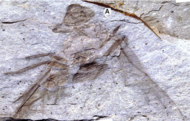 Titanomyrma sp. | |||
|
†Xorides lambei[37] |
(Handlirsch, 1910) |
A xoridine ichneumon parasitic wasp |
|||
|
Rice, 1968 |
Mecopterans
| Family | Genus | Species | Authority | Notes | Images |
|---|---|---|---|---|---|
|
†Dinokanaga wilsoni[43] |
Archibald, 2005 |
A dinopanorpid scorpion fly |
|||
|
†Eomerope |
†Eomerope simpkinsae[44] |
Archibald & Rasnitsyn, 2018 |
An eomeropid scorpionfly |
Neuropterans
| Family | Genus | Species | Authority | Notes | Images |
|---|---|---|---|---|---|
|
†Ricaniella |
†Ricaniella antiquata[45] |
(Scudder, 1895) |
A Polystoechotid-group giant lacewing[46] |
Odonata
| Family | Genus | Species | Authority | Notes | Images |
|---|---|---|---|---|---|
|
Cf. †Dysagrionidae |
†Allenbya |
†Allenbya holmesae[47] |
Archibald & Cannings, 2022 |
A possible Dysagrionidae odonate. |
Raphidiopterans
| Family | Genus | Species | Authority | Notes | Images |
|---|---|---|---|---|---|
|
†Megaraphidia |
†Megaraphidia hopkinsi[48] |
Archibald & Makarkin, 2021 |
Vertebrates
| Family | Genus | Species | Authors | Notes | Images |
|---|---|---|---|---|---|
|
Cf. Amia |
†"Amia" hesperia[49] |
Wilson, 1982 |
A bowfin |
||
|
Aves incertae sedis |
Unidentified |
Unidentified[50] |
Mayr et al., 2019 |
Indeterminate feathers and a skeleton |
|
|
†Wilsonium |
(Cope, 1893) |
A catostomid sucker |
|||
|
†Esthonychidae |
(Marsh, 1874) |
A tillodont species |
|||
|
Hiodon |
(Hussakof, 1916) |
A mooneye |
|||
|
†Libotoniidae |
†Libotonius blakeburnensis[51] |
Wilson, 1977 |
A percopsiform fish |
||
|
†Cf. Eosalmo driftwoodensis[51] |
Wilson, 1977 |
An ancestral salmon |
|||
|
Cf. Apalone |
Undescribed[57] |
A soft shelled turtle |
Princeton Chert biota
The Princeton chert biota is unique in the Allenby formation due to the silicification of the chert, which has resulted in cellular and anatomical preservation of the organisms. As of 2016 over 30 different plant taxa had been described from chert fossils along with a number of fungal species.[58]
Fungi
| Order | Genus | Species | Authors | Notes | Images |
|---|---|---|---|---|---|
|
†Cryptodidymosphaerites princetonensis[59] |
Currah, Stockey, LePage |
An ascomycetan fungus on the host palm Uhlia allenbyensis |
|||
|
†Monodictysporites |
†Monodictysporites princetonensis[60] |
Klymiuk |
An ascomycotan fungus |
||
|
†Palaeoserenomyces |
†Palaeoserenomyces allenbyensis[59] |
Currah, Stockey, LePage |
An ascomycetan fungus on the host palm Uhlia allenbyensis |
Ferns
| Family | Genus | Species | Authors | Notes | Images |
|---|---|---|---|---|---|
|
†Dickwhitea |
†Dickwhitea allenbyensis[61] |
Karafit et al. |
|||
|
†Makotopteris |
†Makotopteris princetonensis[62] |
Stockey, Nishida, & Rothwell |
|||
|
†Trawetsia |
†Trawetsia princetonensis[63] |
Smith et al. |
|||
|
†Dennstaedtiopsis |
†Dennstaedtiopsis aerenchymata[64] |
Cevallos-Ferriz, Stockey, & Pigg |
|||
|
Undescribed[65] |
An osmundaceous fern |
Conifers
| Family | Genus | Species | Authors | Notes | Images |
|---|---|---|---|---|---|
|
†Metasequoia milleri[66] |
Bassinger |
||||
|
†Pinus allisonii[67] |
Stockey |
A 2-needled Pine foliage |
|||
|
†Pinus andersonii[67] |
Stockey |
A 3-needled Pine foliage |
|||
|
Miller |
A basal Pine |
||||
|
†Pinus princetonensis[67] |
Stockey |
A pinaceous cone |
|||
|
Miller |
A basal Pine |
Angiosperms
| Family | Genus | Species | Authors | Notes | Images |
|---|---|---|---|---|---|
|
†Heleophyton |
†Heleophyton helobieoides[70] |
Erwin & Stockey |
An aquatic or emergent water-plantain |
||
|
†Aponogeton longispinosum[71] |
Grímsson, Zetter, & Halbritter |
A Cape-pondweed pollen |
|||
|
†Keratosperma |
†Keratosperma allenbyensis[72] |
Cevallos-Ferriz & Stockey |
An arum family member |
||
|
†Uhlia allenbyensis[73] |
Erwin & Stockey |
||||
|
Undescribed[74] |
Cevallos-Ferriz |
A current fruit |
|||
|
†Decodon allenbyensis[75] |
Cevallos-Ferriz & Stockey |
||||
|
†Liriodendroxylon |
†Liriodendroxylon princetonensis[76] |
Cevallos-Ferriz & Stockey |
A Liriodendron-like wood. |
||
|
†Paleomyrtinaea |
†Paleomyrtinaea princetonensis[77] |
Pigg, Stockey & Maxwell |
A Myrtaceous fruit |
||
|
†Allenbya |
†Allenbya collinsonae[78] |
Cevallos-Ferriz & Stockey |
A water lily relative |
||
|
†Diplopanax eydei[79] |
Stockey, LePage, & Pigg |
A tuplo relative. |
|||
|
†Paleorosa |
†Paleorosa similkameenensis[80] |
Bassinger |
A rose family flower |
||
|
†Prunus allenbyensis[81] |
Cevallos-Ferriz & Stockey |
A prunoid wood. |
|||
|
"Species 1"[81] |
Cevallos-Ferriz & Stockey |
A prunoid seed. |
|||
|
"Species 2"[81] |
Cevallos-Ferriz & Stockey |
A prunoid seed. |
|||
|
"Species 3"[81] |
Cevallos-Ferriz & Stockey |
A prunoid seed. |
|||
|
†Wehrwolfea |
†Wehrwolfea striata[82] |
Erwin & Stockey |
A possible dodonaecous soapberry family flower |
||
|
†Saururus tuckerae[83] |
Smith & Stockey |
A lizard's-tail species |
|||
|
Cevallos-Ferriz & Stockey |
A grape family fruit of uncertain generic placement[85] |
||||
|
incertae sedis |
"Type 1"[84] |
Cevallos-Ferriz & Stockey |
A grape family fruit of uncertain generic placement |
||
|
incertae sedis |
"Type 2"[84] |
Cevallos-Ferriz & Stockey |
A grape family fruit of uncertain generic placement |
||
|
Cf. Iridaceae |
†Pararisteapollis |
†Pararisteapollis stockeyi[86] |
Zetter & Hesse |
A possible iridaceous pollen morphotype |
|
|
†Eorhiza |
†Eorhiza arnoldii[87] |
Robison & Person |
A semi-aquatic dicot of uncertain affinity. |
||
|
†Ethela |
†Ethela sargentiana[88] |
Erwin & Stockey |
A cyperaceous or juncaceous monocot |
||
|
†Princetonia |
Stockey |
A possibly aquatic magnoliopsid flower of uncertain affiliation. |
|||
|
†Soleredera |
†Soleredera rhizomorpha[91] |
Erwin & Stockey |
A lilialean genus of uncertain placement |
References
- ↑ 1.0 1.1 1.2 1.3 1.4 1.5 1.6 Mustoe, G. (2010). "Cyclic sedimentation in the Eocene Allenby Formation of south-central British Columbia and the origin of the Princeton Chert fossil beds". Canadian Journal of Earth Sciences 48 (1): 25–43. doi:10.1139/e10-085.
- ↑ 2.00 2.01 2.02 2.03 2.04 2.05 2.06 2.07 2.08 2.09 2.10 2.11 2.12 2.13 2.14 2.15 2.16 2.17 2.18 2.19 2.20 2.21 2.22 2.23 2.24 2.25 2.26 2.27 2.28 2.29 2.30 2.31 2.32 2.33 2.34 2.35 2.36 2.37 2.38 2.39 2.40 2.41 2.42 2.43 2.44 2.45 2.46 2.47 2.48 2.49 2.50 2.51 2.52 2.53 2.54 2.55 2.56 2.57 2.58 2.59 2.60 2.61 Dillhoff, R.M.; Dillhoff, T.A.; Greenwood, D.R.; DeVore, M.L.; Pigg, K.B. (2013). "The Eocene Thomas Ranch flora, Allenby Formation, Princeton, British Columbia, Canada". Botany 91 (8): 514–529. doi:10.1139/cjb-2012-0313.
- ↑ Greenwood, D.R.; Pigg, K.B.; Basinger, J.F.; DeVore, M.L. (2016). "A review of paleobotanical studies of the Early Eocene Okanagan (Okanogan) Highlands floras of British Columbia, Canada, and Washington, U.S.A.". Canadian Journal of Earth Sciences 53 (6): 548–564. doi:10.1139/cjes-2015-0177. Bibcode: 2016CaJES..53..548G.
- ↑ 4.0 4.1 Archibald, S.; Greenwood, D.; Smith, R.; Mathewes, R.; Basinger, J. (2011). "Great Canadian Lagerstätten 1. Early Eocene Lagerstätten of the Okanagan Highlands (British Columbia and Washington State)". Geoscience Canada 38 (4): 155–164.
- ↑ 5.0 5.1 DeVore, M. L.; Nyandwi, A.; Eckardt, W.; Bizuru, E.; Mujawamariya, M.; Pigg, K. B. (2020). "Urticaceae leaves with stinging trichomes were already present in latest early Eocene Okanogan Highlands, British Columbia, Canada". American Journal of Botany 107 (10): 1449–1456. doi:10.1002/ajb2.1548. PMID 33091153.
- ↑ Penhallow, D.P. (1908). "A report on Tertiary plants of British Columbia, collected by Lawrence M. Lambe in 1906 together with a discussion of previously recorded Tertiary floras". Report 1013. Canada Department of Mines, Geological Survey Branch. pp. 1–167.
- ↑ Shaw, W. S. (1952). "The Princeton Coalfield, British Columbia.". Geological Survey of Canada.
- ↑ 8.0 8.1 8.2 Arnold, C. A. (1955). "A Tertiary Azolla from British Columbia". Contributions from the Museum of Paleontology, University of Michigan 12 (4): 37–45. http://deepblue.lib.umich.edu/bitstream/2027.42/48289/2/ID129.pdf.
- ↑ 9.0 9.1 9.2 9.3 9.4 9.5 9.6 9.7 Grímsson, F.; Grimm, G.; Zetter, R.; Denk, T. (2016). "Cretaceous and Paleogene Fagaceae from North America and Greenland: evidence for a Late Cretaceous split between Fagus and the remaining Fagaceae". Acta Palaeobotanica 56 (2): 247–305. doi:10.1515/acpa-2016-0016.
- ↑ 10.0 10.1 Kuc, M. (1972). "Muscites eocenicus sp. nov.—a fossil moss from the Allenby Formation (middle Eocene), British Columbia". Canadian Journal of Earth Sciences 9 (5): 600–602. doi:10.1139/e72-049. Bibcode: 1972CaJES...9..600K.
- ↑ 11.0 11.1 11.2 11.3 11.4 11.5 Kuc, M. (1974). "Fossil mosses from the bisaccate zone of the mid-Eocene Allenby Formation, British Columbia". Canadian Journal of Earth Sciences 11 (3): 409–421. doi:10.1139/e74-037. Bibcode: 1974CaJES..11..409K.
- ↑ 12.0 12.1 12.2 Dawson, J. W. (1890). On fossil plants from the Similkameen Valley and other places in the southern interior of British Columbia.. Royal Society of Canada.
- ↑ 13.0 13.1 13.2 Miller, N. G. (1980). "Fossil mosses of North America and their significance". The Mosses of North America. pp. 9–36.
- ↑ 14.0 14.1 Mustoe, G.E. (2002). "Eocene Ginkgo leaf fossils from the Pacific Northwest". Canadian Journal of Botany 80 (10): 1078–1087. doi:10.1139/b02-097.
- ↑ 15.0 15.1 15.2 15.3 15.4 15.5 15.6 15.7 Arnold, C. A. (1955). "Tertiary conifers from the Princeton coal field of British Columbia". University of Michigan: Contributions from the Museum of Paleontology 12: 245–258. https://deepblue.lib.umich.edu/bitstream/handle/2027.42/48297/ID137.pdf?sequence=2&isAllowed=y.
- ↑ 16.0 16.1 Chaney, R.W. (1951). "A revision of fossil Sequoia and Taxodium in western North America based on the recent discovery of Metasequoia". Transactions of the American Philosophical Society 40 (3): 231.
- ↑ 17.0 17.1 LePage, B. A.; Basinger, J. F. (1995). "Evolutionary history of the genus Pseudolarix Gordon (Pinaceae)". International Journal of Plant Sciences 156 (6): 910–950. doi:10.1086/297313.
- ↑ Gooch, N. L. (1992). "Two new species of Pseudolarix Gordon (Pinaceae) from the middle Eocene of the Pacific Northwest". PaleoBios 14: 13–19.
- ↑ 19.0 19.1 19.2 19.3 19.4 19.5 19.6 19.7 Wolfe, J.A.; Wehr, W.C. (1987). Middle Eocene dicotyledonous plants from Republic, northeastern Washington (Report). Bulletin. United States Geological Survey. pp. 1–25. doi:10.3133/b1597. B-1597.
- ↑ Pigg, K. B.; Bryan, F. A.; DeVore, M. L. (2018). "Paleoallium billgenseli gen. et sp. nov.: fossil monocot remains from the latest Early Eocene Republic Flora, northeastern Washington State, USA". International Journal of Plant Sciences 179 (6): 477–486. doi:10.1086/697898.
- ↑ Bogner, J.; Johnson, K. R.; Kvacek, Z.; Upchurch, G. R. (2007). "New fossil leaves of Araceae from the Late Cretaceous and Paleogene of western North America". Zitteliana A (47): 133–147. ISSN 1612-412X. https://digital.library.txstate.edu/bitstream/handle/10877/2570/fulltext.pdf?sequence=1.
- ↑ Pigg, K.B.; Manchester S.R.; Wehr W.C. (2003). "Corylus, Carpinus, and Palaeocarpinus (Betulaceae) from the Middle Eocene Klondike Mountain and Allenby Formations of Northwestern North America". International Journal of Plant Sciences 164 (5): 807–822. doi:10.1086/376816.
- ↑ 23.0 23.1 Greenwood, D.R.; Archibald, S.B.; Mathewes, R.W; Moss, P.T. (2005). "Fossil biotas from the Okanagan Highlands, southern British Columbia and northeastern Washington State: climates and ecosystems across an Eocene landscape". Canadian Journal of Earth Sciences 42 (2): 167–185. doi:10.1139/e04-100. Bibcode: 2005CaJES..42..167G.
- ↑ Dillhoff, R.M.; Leopold, E.B.; Manchester, S.R. (2005). "The McAbee flora of British Columbia and its relations to the Early-Middle Eocene Okanagan Highlands flora of the Pacific Northwest". Canadian Journal of Earth Sciences 42 (2): 151–166. doi:10.1139/e04-084. Bibcode: 2005CaJES..42..151D. http://www.fossilmuseum.net/Fossil_Sites/mcabee/mcabeefossils.pdf.
- ↑ DeVore, M. L.; Pigg, K. B. (2007). "A brief review of the fossil history of the family Rosaceae with a focus on the Eocene Okanogan Highlands of eastern Washington State, USA, and British Columbia, Canada". Plant Systematics and Evolution 266 (1–2): 45–57. doi:10.1007/s00606-007-0540-3.
- ↑ DeVore, M.L.; Moore, S.M.; Pigg, K.B.; Wehr, W.C. (2004). "Fossil Neviusia leaves (Rosaceae: Kerrieae) from the Lower Middle Eocene of Southern British Columbia". Rhodora 12 (927): 197–209. https://www.biodiversitylibrary.org/page/32864720.
- ↑ Wolfe, J.A.; Wehr, W.C. (1988). "Rosaceous Chamaebatiaria-like foliage from the Paleogene of western North America". Aliso 12 (1): 177–200. doi:10.5642/aliso.19881201.14. https://pubs.er.usgs.gov/publication/70014287.
- ↑ 28.0 28.1 28.2 28.3 28.4 28.5 28.6 Wolfe, J.A.; Tanai, T. (1987). "Systematics, Phylogeny, and Distribution of Acer (maples) in the Cenozoic of Western North America". Journal of the Faculty of Science, Hokkaido University. Series 4, Geology and Mineralogy 22 (1): 23, 74, 75, 240, & plate 4. http://eprints.lib.hokudai.ac.jp/dspace/handle/2115/36747?mode=full&submit_simple=Show+full+item+record.
- ↑ Manchester, S.; Pigg, K. B.; Kvaček, Z; DeVore, M. L.; Dillhoff, R. M. (2018). "Newly recognized diversity in Trochodendraceae from the Eocene of western North America". International Journal of Plant Sciences 179 (8): 663–676. doi:10.1086/699282.
- ↑ Denk, T.; Dillhoff, R.M. (2005). "Ulmus leaves and fruits from the Early-Middle Eocene of northwestern North America: systematics and implications for character evolution within Ulmaceae". Canadian Journal of Botany 83 (12): 1663–1681. doi:10.1139/b05-122.
- ↑ Wang, Y.; Manchester, S. R. (2000). "Chaneya, a new genus of winged fruit from the Tertiary of North America and eastern Asia". International Journal of Plant Sciences 161 (1): 167–178. doi:10.1086/314227. PMID 10648207.
- ↑ 32.0 32.1 32.2 32.3 32.4 32.5 32.6 Russell, L. S. (1957). "Mollusca from the Tertiary of Princeton, British Columbia". National Museum of Canada Bulletin 147: 84–95.
- ↑ 33.0 33.1 Douglas, S.; Stockey, R. (1996). "Insect fossils in middle Eocene deposits from British Columbia and Washington State: faunal diversity and geological range extensions". Canadian Journal of Zoology 74 (6): 1140–1157. doi:10.1139/z96-126.
- ↑ 34.0 34.1 34.2 Scudder, S. H (1895). "Canadian fossil insects, myriapods and arachnids, Vol II. The Coleoptera hitherto found fossil in Canada". Geological Survey of Canada Contributions to Canadian Palaeontology 2: 5–26.
- ↑ 35.00 35.01 35.02 35.03 35.04 35.05 35.06 35.07 35.08 35.09 35.10 Scudder, S. H (1879). "Appendix A. The fossil insects collected in 1877, by Mr. G.M. Dawson, in the interior of British Columbia". Geological Survey of Canada, Report of Progress for 1877-1878: 175–185.
- ↑ 36.00 36.01 36.02 36.03 36.04 36.05 36.06 36.07 36.08 36.09 36.10 36.11 36.12 36.13 36.14 36.15 36.16 36.17 36.18 36.19 36.20 36.21 36.22 36.23 36.24 36.25 36.26 Rice, H. M. A (1959). "Fossil Bibionidae (Diptera) from British Columbia". Geological Survey of Canada Bulletin 55: 1–36.
- ↑ 37.00 37.01 37.02 37.03 37.04 37.05 37.06 37.07 37.08 37.09 37.10 37.11 37.12 37.13 37.14 37.15 Handlirsch, A. (1910). "Canadian fossil Insects. 5. Insects from the Tertiary lake deposits of the southern interior of British Columbia, collected by Mr. Lawrence M. Lambe". Contributions to Canadian Palaeontology 2 (3): 93–129.
- ↑ 38.0 38.1 Evenhuis (1994). Catalogue of the Fossil Flies of the World (Insecta: Diptera). Backhuys Publishers. pp. 1–600.
- ↑ Handlirsch, A. (1909). "Zur Phylogenie und Flügelmorphologie der Ptychopteriden (Dipteren)". Annalen des Kaiserlich-Königlichen Naturhistorischen Hofmuseums 23: 263–272.
- ↑ 40.00 40.01 40.02 40.03 40.04 40.05 40.06 40.07 40.08 40.09 40.10 40.11 Scudder, S. H (1895). "Canadian fossil insects, myriapods and arachnids, 1. The Tertiary Hemiptera of British Columbia". Geological Survey of Canada Contributions to Canadian Palaeontology 2: 5–26.
- ↑ 41.0 41.1 Archibald, S.; Mathewes, R.; Aase, A. (2023). "Eocene giant ants, Arctic intercontinental dispersal, and hyperthermals revisited: discovery of fossil Titanomyrma (Hymenoptera: Formicidae: Formiciinae) in the cool uplands of British Columbia, Canada". The Canadian Entomologist 155 (e6). doi:10.4039/tce.2022.49.
- ↑ Rice, H.M.A. (1968). "Two Tertiary sawflies, (Hymenoptera - Tenthredinidae), from British Columbia". Geological Survey of Canada 67 (59): 1–21.
- ↑ Archibald, S.B. (2005). "New Dinopanorpidae (Insecta: Mecoptera) from the Eocene Okanagan Highlands (British Columbia, Canada and Washington State, USA)". Canadian Journal of Earth Sciences 42 (2): 119–136. doi:10.1139/e04-073. Bibcode: 2005CaJES..42..119A.
- ↑ Archibald, S. B.; Rasnitsyn, A. P. (2018). "Two new species of fossil Eomerope (Mecoptera: Eomeropidae) from the Ypresian Okanagan Highlands, far-western North America, and Eocene Holarctic dispersal of the genus". The Canadian Entomologist 150 (3): 393–403. doi:10.4039/tce.2018.13.
- ↑ Meunier, F. (1897). "Observations sur quelques insectes du Corallien de la Bavière". Rivista Italiana di Paleontologia 3: 18–23.
- ↑ Shcherbakov, D. E. (2006). "The earliest find of Tropiduchidae (Homoptera: Auchenorrhyncha), representing a new tribe, from the Eocene of Green River, USA, with notes on the fossil record of higher Fulgoroidea". Russian Entomological Journal 15: 315–322.
- ↑ Archibald, S. B.; Cannings, R. A. (2022). "The first Odonata from the early Eocene Allenby Formation of the Okanagan Highlands, British Columbia, Canada (Anisoptera, Aeshnidae and cf. Cephalozygoptera, Dysagrionidae)". The Canadian Entomologist 154 (1): e29. doi:10.4039/tce.2022.16.
- ↑ Archibald, S. B.; Makarkin, V. N. (2021). "Early Eocene snakeflies (Raphidioptera) of western North America from the Okanagan Highlands and Green River Formation". Zootaxa 4951 (1): 41–79. doi:10.11646/zootaxa.4951.1.2. PMID 33903413.
- ↑ Wilson, MVH (1982). "A new species of the fish Amia from the Middle Eocene of British Columbia". Palaeontology 25 (2): 413–424.
- ↑ Mayr, G.; Archibald, S.B.; Kaiser, G.W.; Mathewes, R.W. (2019). "Early Eocene (Ypresian) birds from the Okanagan Highlands, British Columbia (Canada) and Washington State (USA)". Canadian Journal of Earth Sciences 56 (8): 803–813. doi:10.1139/cjes-2018-0267. Bibcode: 2019CaJES..56..803M.
- ↑ 51.0 51.1 51.2 51.3 Wilson, MVH (1977). "Middle Eocene freshwater fishes from British Columbia". Life Sciences Contributions, Royal Ontario Museum 113: 1–66.
- ↑ Wilson, M. V. (1996). "Fishes from Eocene lakes of the interior". in R. Ludvigsen. Life in stone: a natural history of British Columbia's fossils. Vancouver, BC: The University of British Columbia Press. pp. 212–224.
- ↑ Liu, J. (2021). "Redescription of Amyzon'brevipinne and remarks on North American Eocene catostomids (Cypriniformes: Catostomidae)". Journal of Systematic Palaeontology 19 (9): 677–689. doi:10.1080/14772019.2021.1968966.
- ↑ Russell, L.S. (1935). "A middle Eocene mammal from British Columbia". American Journal of Science 29 (169): 54–55. doi:10.2475/ajs.s5-29.169.54. Bibcode: 1935AmJS...29...54R.
- ↑ Eberle, J.J.; Greenwood, D.R. (2017). "An Eocene brontothere and tillodonts (Mammalia) from British Columbia, and their paleoenvironments". Canadian Journal of Earth Sciences 54 (9): 981–992. doi:10.1139/cjes-2017-0061. Bibcode: 2017CaJES..54..981E.
- ↑ 56.0 56.1 Wilson, M. V. (1978). "Eohiodon woodruffi n. sp.(Teleostei, Hiodontidae), from the Middle Eocene Klondike Mountain Formation near Republic, Washington.". Canadian Journal of Earth Sciences 15 (5): 679–686. doi:10.1139/e78-075. Bibcode: 1978CaJES..15..679W.
- ↑ LePage, B. A.; Currah, R. S.; Stockey, R. A. (1994). "The fossil fungi of the Princeton chert". International Journal of Plant Sciences 155 (6): 828–836. doi:10.1086/297221.
- ↑ Pigg, K. B.; DeVore, M. L. (2016). "A review of the plants of the Princeton chert (Eocene, British Columbia, Canada)". Botany 94 (9): 661–681. doi:10.1139/cjb-2016-0079.
- ↑ 59.0 59.1 Currah, R.S.; Stockey, R.A.; LePage, B.A. (1998). "An Eocene tar spot on a fossil palm and its fungal hyperparasite". Mycologia 90 (4): 667–673. doi:10.1080/00275514.1998.12026955.
- ↑ Klymiuk, A. A. (2016). "Paleomycology of the Princeton Chert. III. Dictyosporic microfungi, Monodictysporites princetonensis gen. et sp. nov., associated with decayed rhizomes of an Eocene semi-aquatic fern". Mycologia 108 (5): 882–890. doi:10.3852/15-022. PMID 27302048.
- ↑ Karafit, S. J.; Rothwell, G. W.; Stockey, R. A.; Nishida, H. (2006). "Evidence for sympodial vascular architecture in a filicalean fern rhizome: Dickwhitea allenbyensis gen. et sp. nov.(Athyriaceae)". International Journal of Plant Sciences 167 (3): 721–727. doi:10.1086/501036.
- ↑ Stockey, R. A.; Nishida, H.; Rothwell, G. W. (1999). "Permineralized ferns from the middle Eocene Princeton chert. I. Makotopteris princetonensis gen. et sp. nov.(Athyriaceae)". International Journal of Plant Sciences 160 (5): 1047–1055. doi:10.1086/314191. PMID 10506480.
- ↑ Smith, S. Y.; Stockey, R. A.; Nishida, H.; Rothwell, G. W. (2006). "Trawetsia princetonensis gen. et sp. nov.(Blechnaceae): a permineralized fern from the Middle Eocene Princeton Chert". International Journal of Plant Sciences 167 (3): 711–719. doi:10.1086/501034.
- ↑ Cevallos-Ferriz, S. R.; Stockey, R. A.; Pigg, K. B. (1991). "The Princeton chert: evidence for in situ aquatic plants". Review of Palaeobotany and Palynology 70 (1–2): 173–185. doi:10.1016/0034-6667(91)90085-H. Bibcode: 1991RPaPa..70..173C.
- ↑ Collinson, M. E. (2001). "Cainozoic ferns and their distribution". Brittonia 53 (2): 173–235. doi:10.1007/BF02812700.
- ↑ Basinger, J. F. (1981). "The vegetative body of Metasequoia milleri from the Middle Eocene of southern British Columbia". Canadian Journal of Botany 59 (12): 2379–2410. doi:10.1139/b81-291.
- ↑ 67.0 67.1 67.2 Stockey, R. A. (1984). "Middle Eocene Pinus remains from British Columbia". Botanical Gazette 145 (2): 262–274. doi:10.1086/337455.
- ↑ 68.0 68.1 Miller Jr, C. N. (1973). "Silicified cones and vegetative remains of Pinus from Eocene of British Columbia". Contributions from the Museum of Paleontology, University of Michigan 24: 101–118.
- ↑ 69.0 69.1 Klymiuk, A. A.; Stockey, R. A.; Rothwell, G. W. (2011). "The first organismal concept for an extinct species of Pinaceae: Pinus arnoldii Miller.". International Journal of Plant Sciences 172 (2): 294–313. doi:10.1086/657649.
- ↑ Erwin, D. M.; Stockey, R. A. (1991). "Silicified monocotyledons from the Middle Eocene Princeton chert (Allenby Formation) of British Columbia, Canada". Review of Palaeobotany and Palynology 70 ((1-2)): 147–162. doi:10.1016/0034-6667(91)90083-F. Bibcode: 1991RPaPa..70..147E.
- ↑ Grímsson, F.; Zetter, R.; Halbritter, H.; Grimm, G. W. (2014). "Aponogeton pollen from the Cretaceous and Paleogene of North America and West Greenland: Implications for the origin and palaeobiogeography of the genus". Review of Palaeobotany and Palynology 200 (100): 161–187. doi:10.1016/j.revpalbo.2013.09.005. PMID 24926107. Bibcode: 2014RPaPa.200..161G.
- ↑ Cevallos-Ferriz, S. R.; Stockey, R. A. (1988). "Permineralized fruits and seeds from the Princeton chert (Middle Eocene) of British Columbia: Araceae". American Journal of Botany 75 (8): 1099–1113. doi:10.1002/j.1537-2197.1988.tb08822.x.
- ↑ Erwin, D.M.; Stockey, R.A. (1994). "Permineralized monocotyledons from the middle Eocene Princeton chert (Allenby Formation) of British Columbia: Arecaceae". Palaeontographica Abteilung B 234: 19–40.
- ↑ Cevallos-Ferriz, S. R. S. (1995). "Fruits of Ribes from the Princeton chert, British Columbia, Canada.". American Journal of Botany 82 (6).
- ↑ Cevallos-Ferriz, S. R.; Stockey, R. A. (1988). "Permineralized fruits and seeds from the Princeton chert (Middle Eocene) of British Columbia: Lythraceae". Canadian Journal of Botany 66 (2): 303–312. doi:10.1139/b88-050.
- ↑ Cevallos-Ferriz, S. R.; Stockey, R. A. (1990). "Vegetative remains of the Magnoliaceae from the Princeton chert (middle Eocene) of British Columbia". Canadian Journal of Botany 68 (6): 1327–1339. doi:10.1139/b90-169.
- ↑ Pigg, K. B.; Stockey, R. A.; Maxwell, S. L. (1993). ""Paleomyrtinaea", a new genus of permineralized myrtaceous fruits and seeds from the Eocene of British Columbia and Paleocene of North Dakota". Canadian Journal of Botany 71 (1): 1–9. doi:10.1139/b93-001.
- ↑ Cevallos-Ferriz, S. R.; Stockey, R. A. (1989). "Permineralized fruits and seeds from the Princeton chert (Middle Eocene) of British Columbia: Nymphaeaceae". Botanical Gazette 150 (2): 207–217. doi:10.1086/337765.
- ↑ Stockey, R. A.; LePage, B. A.; Pigg, K. B. (1998). "Permineralized fruits of Diplopanax (Cornaceae, Mastixioideae) from the middle Eocene Princeton chert of British Columbia". Review of Palaeobotany and Palynology 103 (3–4): 223–234. doi:10.1016/S0034-6667(98)00038-4. Bibcode: 1998RPaPa.103..223S.
- ↑ Basinger, JF (1976). "Paleorosa similkameenensis, gen. et sp. nov., permineralized flowers (Rosaceae) from the Eocene of British Columbia". Canadian Journal of Botany 54 (20): 2293–2305. doi:10.1139/b76-246.
- ↑ 81.0 81.1 81.2 81.3 Cevallos-Ferriz, S. R.; Stockey, R. A. (1990). "Vegetative remains of the Rosaceae from the Princeton chert (Middle Eocene) of British Columbia". IAWA Journal 11 (3): 261–280. doi:10.1163/22941932-90001183.
- ↑ Erwin, D. M.; Stockey, R. A. (1990). "Sapindaceous flowers from the Middle Eocene Princeton chert (Allenby Formation) of British Columbia, Canada". Canadian Journal of Botany 68 (9): 2025–2034. doi:10.1139/b90-265.
- ↑ Smith, S. Y.; Stockey, R. A. (2007). "Establishing a fossil record for the perianthless Piperales: Saururus tuckerae sp. nov.(Saururaceae) from the Middle Eocene Princeton Chert.". American Journal of Botany 94 (10): 1642–1657. doi:10.3732/ajb.94.10.1642. PMID 21636361.
- ↑ 84.0 84.1 84.2 Cevallos-Ferriz, S. R.; Stockey, R. A. (1990). "Permineralized fruits and seeds from the Princeton chert (Middle Eocene) of British Columbia: Vitaceae". Canadian Journal of Botany 68 (2): 288–295. doi:10.1139/b90-039.
- ↑ 85.0 85.1 Chen, I.; Manchester, S. R. (2007). "Seed morphology of modern and fossil Ampelocissus (Vitaceae) and implications for phytogeography". American Journal of Botany 94 (9): 1534–1553. doi:10.3732/ajb.94.9.1534. PMID 21636520.
- ↑ Hesse, M.; Zetter, R. (2005). "Ultrastructure and diversity of recent and fossil zona-aperturate pollen grains". Plant Systematics and Evolution 255 (3): 145–176. doi:10.1007/s00606-005-0358-9.
- ↑ Robison, C. R.; Person, C. P. (1973). "A silicified semiaquatic dicotyledon from the Eocene Allenby Formation of British Columbia". Canadian Journal of Botany 51 (7): 1373–1377. doi:10.1139/b73-172.
- ↑ Erwin, D. M.; Stockey, R. A. (1992). "Vegetative body of a permineralized monocotyledon from the Middle Eocene Princeton chert of British Columbia". Courier Forschungsinstitut Senckenberg 147: 309–327.
- ↑ Stockey, R. A. (1987). "A permineralized flower from the Middle Eocene of British Columbia". American Journal of Botany 74 (12): 1878–1887. doi:10.1002/j.1537-2197.1987.tb08790.x.
- ↑ Stockey, R. A.; Pigg, K. B. (1991). "Flowers and fruits of Princetonia allenbyensis (Magnoliopsida; family indet.) from the Middle Eocene Princeton chert of British Columbia". Review of Palaeobotany and Palynology 70 (1–2): 163–172. doi:10.1016/0034-6667(91)90084-G. Bibcode: 1991RPaPa..70..163S.
- ↑ Erwin, D. M.; Stockey, R. A. (1991). "Soleredera rhizomorpha gen. et sp. nov., a permineralized monocotyledon from the Middle Eocene Princeton chert of British Columbia, Canada". Botanical Gazette 152 (2): 231–247. doi:10.1086/337885.
 |
